
More Biology of the Monarch Butterfly
Life Cycle |
(Click thumbnail images for larger photos.) |
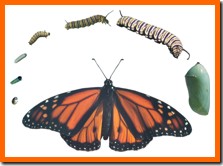 The life cycle of monarchs involves what is termed
"complete metamorphosis". That is, they pass through four
distinct stages that include: egg, larva (caterpillar), pupa
(chrysalis) and winged adult. Complete metamorphosis
involves the transformation from the larval to the adult
stage via a resting or pupal stage. Other insects have
"incomplete metamorphosis", where the change from larval to
adult stages is more gradual, with no distinct pupal stage.
A good example of incomplete metamorphosis would be
grasshoppers, which develop progressively, with each larval
stage looking more and more like the adult grasshopper.
The life cycle of monarchs involves what is termed
"complete metamorphosis". That is, they pass through four
distinct stages that include: egg, larva (caterpillar), pupa
(chrysalis) and winged adult. Complete metamorphosis
involves the transformation from the larval to the adult
stage via a resting or pupal stage. Other insects have
"incomplete metamorphosis", where the change from larval to
adult stages is more gradual, with no distinct pupal stage.
A good example of incomplete metamorphosis would be
grasshoppers, which develop progressively, with each larval
stage looking more and more like the adult grasshopper.
In their Mexican wintering grounds and along the migration route back to Manitoba, the male and female butterflies will mate. Males have special patches on their hind wings, called "stigmata", containing scent scales, called "androconia" which release pheromones (a pheromone is an airborne substance, a chemical or scent, used in communication) that may help to attract females or aid in species recognition. After a brief aerial courtship the pair will mate. They mate by joining the tips of their abdomens together and the male passes sperm to the female. Mated pairs stay joined for several hours and can even fly off together if disturbed. In this case only the one adult will fly and the other will be carried along. (I don't know which, male or female, or both alternately, does the flying in such cases.)
Report Monarch Sightings directly at: Journey North |
| Check out these projects: | |
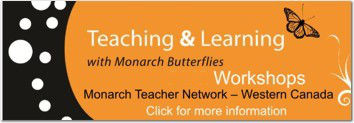 |
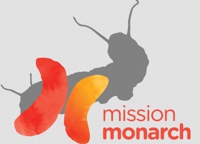 |
When their eggs are ready to be laid, females search out milkweed plants on which to lay them. They find their way unerringly to milkweeds, navigating by scent until they find a patch. Apparently the females will also "test" individual plants by scratching them with a foot to determine if they are, in fact, milkweeds. (Butterflies and many other insects have chemical receptors - noses - in their feet.) The eggs are laid, singly, on the undersides of leaves or flower buds. A female may lay several eggs individually throughout a patch of milkweed, then will fly off to find more plants. One female may lay hundreds of eggs over her life time.
Play this video to see the entire life cycle of a monarch.
The eggs hatch after about 7-10 days, depending on the temperature (a cooler environment slows development at all stages). At hatching the caterpillars are only about 4 mm long, but like all caterpillars, they are eating machines and they grow rapidly. The caterpillars will shed their skins 4 times, passing through 5 stages, called "instars". In 2 or 3 weeks they will reach full size, about 50 mm long, having increased in weight about 3000 fold! When they are ready to pupate they leave the plants where they have been feeding to search out a safe place to pupate.
Once the caterpillar has found what it considers to be a safe place, usually under a leaf, branch or building overhang, it will spin a small silk pad and attach itself to the pad by its hind feet. The caterpillar then "goes J" and hangs upside down from the silk pad. About a day later it sheds its skin to enter the chrysalis (pupa) stage.
Play this video to watch the entire pupation process in real time.
The metamorphosis occurring within the chrysalis can take from 7-21 days depending on the temperature. (I witnessed one butterfly emerge in mid-September after being in the chrysalis for 21 days!) In very warm conditions an entire monarch generation, from egg to adult, may take only 4 weeks. In Manitoba, with our cooler temperatures, generation times are more likely to be 5-6 weeks. You can tell when the adult butterfly is going to emerge, because a day or so before it does, the chrysalis becomes translucent and the pigments in its body darken, so you can see the butterfly within.

Adult butterflies emerge from the chrysalis with shriveled wings and squat, puffy bodies. They will hang beneath the chrysalis skin and pump fluid into the wings to inflate them. Newly emerged butterflies secrete an unpleasant smelling liquid, called "meconium", that contains the waste materials from the chrysalis stage. After a couple of hours the butterfly's wings will be fully formed and dried, and it will be able to fly off in search of food and a mate.
Play this video to watch the entire emergence (eclosion) process in real time.
Further south in North America, adults that have pupated
and emerged when day length is still increasing and
temperatures are warm will be sexually mature. They will
seek out mates, breed and continue the northward migration.
As summer progresses and day length begins to decrease, and
temperatures start to  drop, changes will occur in the
developing monarchs. Emerging adults will not be sexually
mature and they will begin to migrate southward. Only with
the lengthening of days the following spring in the
mountains of central Mexico will these butterflies become
sexually mature.
drop, changes will occur in the
developing monarchs. Emerging adults will not be sexually
mature and they will begin to migrate southward. Only with
the lengthening of days the following spring in the
mountains of central Mexico will these butterflies become
sexually mature.
In Manitoba, monarchs don't get here until June, and the first batch of adults that are hatched here, by mid to late July, may or may not be sexually active. If we have a long warm summer, and the monarchs have gotten here early, then we can have two generations of adult monarchs emerge. In shorter, cooler summers, we may have only one generation emerge. In either case, the last batch of adults to emerge from their chrysalises in Manitoba will make the astonishing journey all the way to Mexico and back to, at least, southern Texas the following spring. Only the children or grandchildren of our Manitoba born monarchs will return to this province in successive years (return to Monarch Migration).
Populations
There is still a lot of controversy over the total population of monarchs in the eastern part of North America. The only chance experts get to estimate the population is at the wintering grounds in Mexico. Suggestions of 10's of millions to 100's of millions have been made over the years. And the population is known to fluctuate wildly from year to year. Bad weather can decimate up to 90% of the overwintering population in any given year, but a good growing season in the north can boost numbers back up.
Beware of what you hear from the media on the subject of monarch populations. "Monarchs are endangered! Monarchs are endangered! The sky is falling! The sky is falling!" There has been considerable coverage in past years of the "plight" of the monarch in its wintering sites in central Mexico. "Rampant logging", "unheard-of frosts" and other "sky is falling" scenarios have been touted in the media, with suggestions that our beloved monarchs may soon go the way of the dodo. While the monarch's migratory nature and dependence on fairly isolated wintering sites do have the potential to be problematic for the species, don't count them out just yet. There is still considerable controversy over the true nature of habitat required for monarchs to overwinter successfully, and they have an enormous potential for recovery from minor or major population losses on the overwintering sites. Remember, monarchs produce at least 3 or 4 generations every year after leaving Mexico. Each generation has the potential to increase the species overall numbers dramatically. Weather and habitat conditions the monarchs face on the way north to Manitoba, and south again to Mexico, probably play at least as great a role in determining the fate of the species, as do events and weather in Mexico.
(Over my life I have seen years when virtually no monarchs could be found in southern Manitoba and some where they seemed to be everywhere. And I've never seen a correlation between dire warnings about the overwintering monarchs and the populations that reach here the following spring. While we should always be vigilant and mindful of the conservation of this, and every species, I think that monarchs are more resilient than the media gives them credit for! The real answers to the mysteries of monarch populations are a lot of research away.)
Genetic Bottleneck!
Recent genetic studies of monarchs have revealed that the entire North American population of this species is very closely related. Some scientists are speculating that monarchs faced near-extinction in the not-too-distant past, perhaps only a few thousand years. It's thought that the overall population was reduced to a very low number, and hence contained little genetic diversity. All three North American populations, which are now geographically isolated, are thought to have stemmed from this small number of monarchs that survived this population bottleneck.
If you grow it, they will come!
If you really want to do something for monarch
butterflies, grow some milkweed! My house in Winnipeg is a
km from the nearest natural habitat containing milkweed
plants, yet each year several female monarchs will find the
patches of milkweeds I grow in my gardens, specifically for
them. I have counted as many as 25 adult monarchs that were
raised and hatched from my small garden! 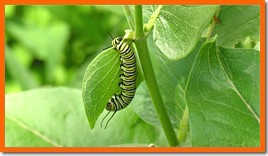 Only in years where
monarchs have been almost absent from Manitoba in general,
has my garden failed to produce several new adults.
Only in years where
monarchs have been almost absent from Manitoba in general,
has my garden failed to produce several new adults.
Manitoba has 6 species of milkweed plants and they are all actively sought out by female monarchs for egg deposition. (There are many more species of milkweeds further south in North America, as there are for most types of plants and animals.) Click the thumbnail image for a look at all our milkweeds.
Seeds and plants of Whorled, Dwarf and Swamp milkweeds are available from some Manitoba growers. Showy and Silky milkweeds are still considered noxious weeds under the Provincial Weed Act and should not be propagated. They are too aggressive for most garden settings, anyway.
|
Monarchs in the Classroom?
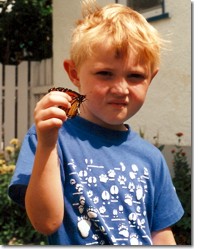 Unfortunately, monarch
butterflies don't arrive in Manitoba until June, very
late in the school year, and too late to raise caterpillars
to adulthood in the class room. Unless you're at summer
school! If you're a teacher contemplating buying monarch caterpillars to bring into your class room, please read this article: Butterflies are free . . . or are they? Then don't do it!
Unfortunately, monarch
butterflies don't arrive in Manitoba until June, very
late in the school year, and too late to raise caterpillars
to adulthood in the class room. Unless you're at summer
school! If you're a teacher contemplating buying monarch caterpillars to bring into your class room, please read this article: Butterflies are free . . . or are they? Then don't do it!
Buying nature at your convenience and out-of-step with natural timelines sends a poor environmental message to kids. Instead, get kids involved with a monarch monitoring program like Journey North Monarch Migration. Or grow a butterfly garden in the school yard! Milkweed plants are easy to grow from seed. They are perennials that will persist for many years. Together with a variety of other plants, to provide food for caterpillars of other species, and some nectar producing flowers, you could create an ideal butterfly garden and monarch nursery right outside your class room. For some how-to information check out our Butterfly Gardening article.
In Conclusion
If we all take care of the habitat that monarch butterflies need in Mexico, along their migration routes, and here in Manitoba, then there will always be marvelous Manitoba monarchs. Just don't expect the governments of three different countries to get together and do all the work. It's up to all of us to make sure that monarchs have a secure future!
Thanks for learning about Manitoba's marvelous migrating monarch butterflies!
Contact NatureNorth
|
Support Our Work You can make a difference! |
Acknowledgments
Some of the information used in this article was drawn from the following publications and web sites.
The Butterflies of Manitoba. 1989. By P. Klassen, A. Westwood, W. Preston and W. McKillop. Published by the Manitoba Museum of Man and Nature.The Peterson Field Guide Series: A Field Guide to the Butterflies of North America, East of the Great Plains. 1979. By A. Klots. Published by Houghton Mifflin Company.
Online Resources
Return to Manitoba Monarchs | Monarch Biology | Summer Issue | NatureNorth Front Page
